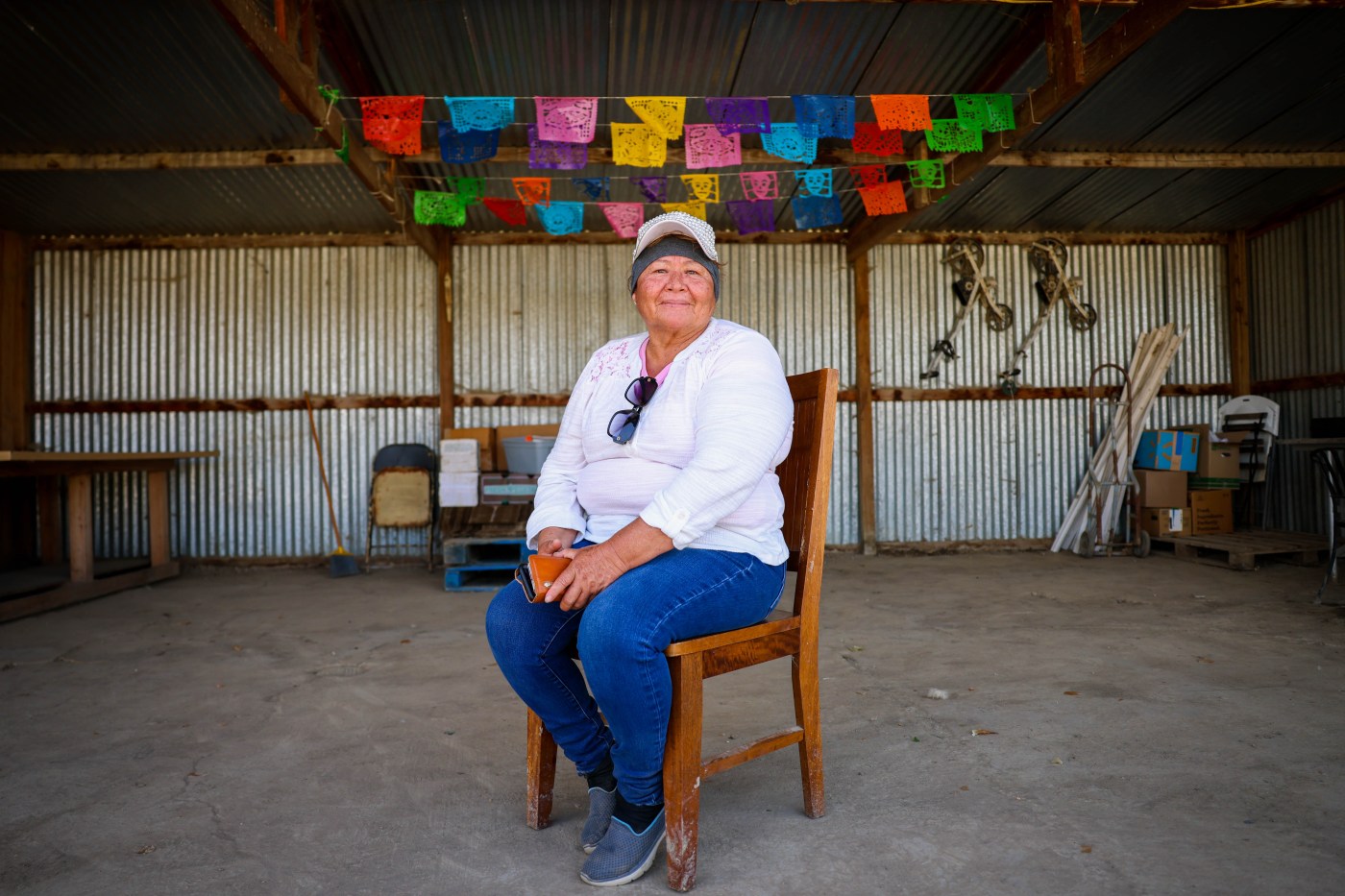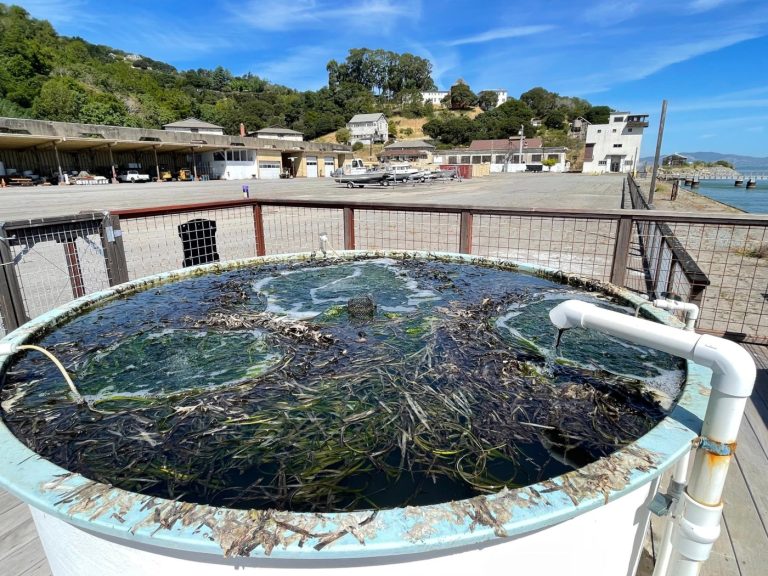As a young woman in the late 1980s, María Inés Catalán joined a gushing stream of laborers from Mexico chasing seasonal crops in California, following the footsteps of her mother and thousands of other itinerant farm workers desperate for jobs.
Now, like an increasing number of other former migrant workers, she’s put down roots as sturdy as the tomatoes in her fields. Manager of the 55-acre, family-owned organic Catalán Farm in Hollister, Catalán is embedded in the community, living on the farm, shopping nearby and hiring local residents.
Julio Cesar Catalan operates a tractor on a 55-acre land leased for her mother Maria Catalan, founder of the organic Catalan Family Farms in Hollister, Calif., on Tuesday, June 19, 2024. (Ray Chavez/Bay Area News Group)
Related Articles
San Jose drops another spot down the list of most populous U.S. cities
Oakland’s homeless population rises 9%, Alameda County population dips 3%
Record wave of Americans fled big cities for small ones in 2023
With fewer Californians and more construction, where are the housing bargains?
California’s great exodus finally slows as population increases after 3-year decline
Her children will never know the uncertainty of finding work, the unrelenting demands of a foreman, the fatigue of constant movement or the pressure to harvest a box of broccoli every minute. What they know now is this: On their own ranch, they make their own decisions.
“They have learned to be independent,” Catalán said. “That’s the only way of life that they know.”
For more than a century, California agriculture has depended on transient labor, with migrants moving from the winter lettuce fields of the south to the autumnal walnut orchards of the north.
But that long and dusty tradition, immortalized in John Steinbeck’s “Grapes of Wrath” and the photos of Dorothea Lange, is fading. New research reveals a profound change in the nature of the nation’s agricultural workforce.
Since the late 1990s, the share of agricultural workers who migrate within the United States to follow the seasonal shift of crops has fallen by nearly 75%, according to an analysis of the U.S. Department of Labor’s National Agricultural Workers Survey data by the Bay Area News Group.
This trend is also reflected in a 2023 study by professor Philip Martin of the UC-Davis Department of Agricultural and Resource Economics. There is less seasonality in agricultural work, he found. While crops still require the most labor during the summer months, employment is rising during the winter and spring.
Many farm workers are aging, settling in farm communities, traveling shorter distances to work and establishing themselves in local businesses.
Others, typically young men, come to the U.S. as “guest workers” to complete one specific task — then go home.
The traditional “follow the crop” migrant farmworkers now represent just 3% of workers surveyed by the U.S. Department of Labor. “Shuttlers,” who work at a single farm location more than 75 miles from home, comprise about 10% of workers, down from 24% in the late 1990s.
One major reason is the changing demographics of farm workers, according to UC Berkeley agricultural economist Jeffrey Perloff in his 2016 paper “Where Did All the Migrant Farm Workers Go?” Workers are older, more settled and more often female. They’ve acquired families, new skills and greater English proficiency. They’re less willing to shuttle across the border or between far-flung jobs.
“Increasingly, workers are trying to figure out how to stay in one region. They’re looking for a better quality of life. Some even buy homes,” said Marc Grossman of the César Chavez Foundation in Keene. “They’re able to escape the John Steinbeck-era migrancy.”
The most coveted jobs are year-round, at places such as Monterey Mushrooms, Gilroy’s Christopher Ranch garlic company and Watsonville’s Coastal Berry Co, owned by Dole. These companies offer stable pay and medical insurance, sometimes even a pension.
“It’s darn close to middle class,” said Armando Elenes of the United Farm Workers in Keene, which won union contracts for workers at Monterey Mushrooms and Dole. He said that salaries can range from $45,000 to $48,000 a year, compared to $25,000 to $30,000 or less out in the fields.
Meanwhile, there are structural changes in Mexico’s labor supply, said Perloff. Fewer and fewer rural Mexicans come seeking work in agriculture. Despite major problems with weapons and drugs, Mexico’s economy is strengthening, with increased exports and stable currency, and more people want non-farm work.
Another reason for the decline in migrant labor is the increased efficiency and productivity of U.S. farms. Farms are larger and more mechanized, and there is reduced need for many unskilled hands.
When San Benito County walnut grower John Swett took over his father’s orchard decades ago, 40 people were needed to handpick 20 acres. The job required speed and precise hand-eye coordination. Now, with mechanization, a crew of six people can pick 450 acres, he said.
What’s needed now is greater skill, said Swett. Trained machine operators, employed by a single harvesting company, might work fulltime on several large farms.
“You’re putting someone on a piece of equipment that’s worth a half a million dollars,” said Swett.
When farms have a specific job to be done — say, pruning, thinning or harvesting their crops — they increasingly rely on labor contractors to bring crews of “guest workers” with H-2A visas that provide no pathway for workers to stay in the U.S. after their jobs are complete.
The number of jobs filled by H-2A workers has quadrupled from fewer than 100,000 a year in 2013 to 378,000 in 2023. They now represent between one-quarter to one-half of agricultural workers in the state. These workers sign contracts to live and work in a specific region, with multiple growers. After weeks or months of work, they’re required to leave.
The shacks and shantytowns occupied by workers in Steinbeck’s famed 1936 “Harvest Gypsies” essays are largely gone. Housing is higher quality and more permanent, such as Gilroy’s 14-unit The Trees and Morgan Hill’s new Royal Oak Village, with 30 apartments for farmworkers. It doesn’t make economic sense for a grower to build and rent out a home for just a month or two.
Catalán’s family had a multi-generational tradition of seasonal work in U.S. fields. Her father and grandfather traveled north in the 1960s with the federal Bracero Program, created to fill agricultural shortages after World War II, then returned home. Those earnings helped support their farm in the southern Mexican state of Guerrero.
In the 1970s, after the Bracero Program ended, her mother repeatedly risked long and dangerous travel to enter the U.S. From Fresno to Salinas, she moved from one temporary job to another, carrying everything she owned with her. The work was physically exhausting and poorly paid. And it was unstable; at any moment, a migrant worker could be told that they’re not needed anymore.
“I missed my mother,” Catalán recalled. “It was hard.”
For seven years, she worked in the fields of the Salinas Valley, packaging broccoli.
“It was very difficult. It’s a very repetitive job. You just do what you’re told,” she said. “I cried many times. I thought: If this is the country of opportunities, where is mine?”
Her life changed after an organic farming training program at the Rural Development Center in Salinas, an “incubator program” that provides training in farming and marketing, and leasing land.
She started Catalán Farms with a half acre, then expanded. Meanwhile, Catalán has founded a nonprofit to help other small Latino farmers acquire organic certification.
Now, tied to the land, the family isn’t going anywhere. Daughter Ana Arlette Lopez, trained as an accountant, does bookkeeping. Son Juan Carlos helps with sales, marketing and licensing. Another son, Julio, helps manage the farm.
“They don’t know how to work in the field for a company,” Catalán said proudly, “with a boss that follows you around.”
Maria Catalan, right, founder of the organic Catalan Family Farms, stands on a tractor operated by her son, Julio Catalan, in the 55-acre land she leases in Hollister, Calif., on Tuesday, June 19, 2024. (Ray Chavez/Bay Area News Group)












